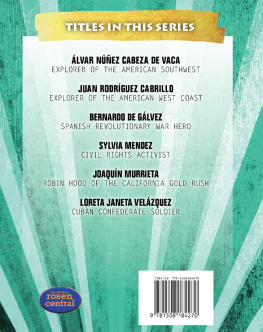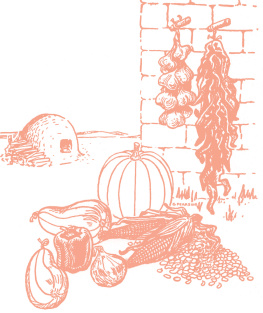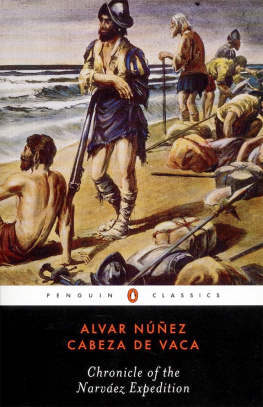
Published in 2020 by The Rosen Publishing Group, Inc. 29 East 21st Street, New York, NY 10010
Copyright 2020 by The Rosen Publishing Group, Inc.
First Edition
All rights reserved. No part of this book may be reproduced in any form without permission in writing from the publisher, except by a reviewer.
Library of Congress Cataloging-in-Publication Data
Names: Colmenares, Sandra, author.
Title: Alvar Nez Cabeza de Vaca: explorer of the American Southwest / Sandra Colmenares.
Description: First edition. | New York: Rosen Central, 2020. | Series: Our voices: Spanish and Latino figures of American history | Includes bibliographical references and index. | Audience: Grades 58.
Identifiers: LCCN 2018014360 | ISBN 9781508184270 (library bound) | ISBN 9781508184263 (pbk.)
Subjects: LCSH: Nez Cabeza de Vaca, Alvar, active 16th century Juvenile literature. | ExplorersAmericaBiographyJuvenile literature. | ExplorersSpainBiographyJuvenile literature. | AmericaDiscovery and explorationSpanishJuvenile literature.
Classification: LCC E125.N9 C65 2019 | DDC 970.01/6092 [B]dc23
LC record available at https://lccn.loc.gov/2018014360
Manufactured in the United States of America
On the cover: lvar Nez Cabeza de Vaca, Alonso del Castillo Maldonado, Andrs Dorantes, and the Arab slave Estevanico were the four survivors of the adventurous expedition to conquer and settle in La Florida.
CONTENTS
INTRODUCTION
T he Spanish conquistador lvar Nez Cabeza de Vacas story is one of the great epics of history. He was many things: hidalgo (an important officer), explorer, and soldier. Not only that, he was a royal official to the Spanish crown during the 1500s, when this European kingdom experienced the most incredible expansion of its power around the known and unknown world.
Cabeza de Vaca, like many hidalgo men of his time, made a living by carrying out the orders and other responsibilities given to him by his lords and the Crown. Like his father, grandfather, and a long line of his ancestors, Cabeza de Vaca was one of historys heroic figures. He helped the Spanish Empire achieve its rule over a great part of Europe as well as a world that was little known until then: the American territory. From the European point of view, this territory was a new world to be discovered.
By the time he was named royal treasurer and second in command in Pnfilo Narvezs expedition, he was already an experienced and distinguished Spanish soldier, noted for his fighting campaigns in Europe, including Spain. He was appointed to explore, conquer, and settle the territory of La Florida in North America, which was unknown territory for the Spanish. At the time, only a few other European explorers had visited the territory that would later become the United States. But Cabeza de Vaca spent eight years wandering this land, taking notes of what he saw and experienced. He later wrote everything he could remember in a document that he called La Relacin, or The Relation. He addressed it to the ruler of the Holy Roman Empire. Charles V.
The Relation was published in Spain for the first time in 1542 and a second time in 1555. But this was by no means the only documentation of these journeys. An earlier document called the Joint Report was written in 1536. The Joint Report is a thirty-page summary of the journey as drawn up by Cabeza de Vaca, together with Alonso del Castillo and Andrs Dorantes, in Mexico and addressed to the Audiencia of Santo Domingo, which was Spains first court in America.

Cabeza de Vaca and his fellow explorers experienced a difficult journey in the unknown lands of La Florida and the North American territory.
As he wandered the North American territory, Cabeza de Vaca learned to love the beautiful land as well as the Native Americans. Although he suffered greatly during this time, he envisioned brotherhood with his fellow humans. He was also determined and willing to bring civilization and Christianity to them. During his journey, Cabeza de Vaca wrote that he learned how to cure the sick, the natives languages, and how to make peace with the hostile natives.
Although the expedition didnt achieve its goals, Cabeza de Vacas accounts of the journey depicts an adventure of the first Europeans in an unknown land and how they managed to survive eight long years.
CHAPTER ONE
THE ORIGINS OF LVAR NEZ CABEZA DE VACA
H istorians have searched for evidence about a precise place and date of Cabeza de Vacas birth for centuries. They have often come up short, however, mainly as a result of a lack of information that supports any one historians theory. Almost any theory could be possible until exact information is discovered, so a variety of arguments have been generally accepted.
WHEN AND WHERE: THE QUEST FOR A BIRTHPLACE AND DATE
Most theories suggest that Cabeza de Vaca was born in one of three cities: Jerez de los Caballeros, province of Extremadura; Seville; or Jerez de la Frontera, province of Andalusia. All three cities are located in the same region of the southern Iberian Peninsula. One theory states that Jerez de los Caballeros was his birthplace, based on the fact that a large branch of the Cabeza de Vaca family lived there. Some believe that he was born in Seville because of registry documents from 1524 in which he is listed as an inhabitant and working for the house of Medina Sidonia. However, there arent any other clues to suggest he grew up there.

Cabeza de Vaca may have been born in the Spanish cities of Jerez de la Frontera, located close by the Gulf of Cdiz in the Southwest, or Seville, located a bit farther inland.
Jerez de la Frontera is most likely his birthplace, for two reasons. First, it is the city where his parents are buried. Second, and more convincingly, it is also the place he identifies as his place of origin in his book La Relacin (The Relation).
As for his birth date, historians have only approximate dates because they have not yet found a legal document or registry. Unfortunately, Cabeza de Vaca did not write about it in La Relacin. Most historical literature agrees that he might have been born between 1485 and 1495.
HEAD OF A COW
In La Relacin, Cabeza de Vaca writes that he is the son of Francisco de Vera and Doa Teresa Cabeza de Vaca, and grandson of Pedro de Vera who conquered the Canaries. His own name, lvar Nez Cabeza de Vaca, comes from his mother. It is in honor of two relatives with the same name: his mothers uncle and her great-grandfather. For reasons that remain unknown, he preferred Cabeza de Vaca, which means head of a cow in Spanish, more than the name Nez.

In the Battle of Las Navas de Tolosa (1212), Christian troops surprise and defeat the Moors. The royal title Cabeza de Vaca may have originated in this critical clash.
One theory is that he was drawn to the history and legend of this name. In a popular Castilian tale from the thirteenth century, a shepherd called Martn Alhaja left a sign that directed the Christian army to a passage through the mountains of Sierra Morena. This allowed seventy thousand Christian soldiers to launch a surprise attack and defeat the Moors army, even though they were outnumbered by one hundred thousand soldiers. The sign that changed the war was a cow skull mounted on a stake. Thus, on July 16, 1212, the Christians won the decisive clash remembered as the Battle of Las Navas de Tolosa. Soon after, the story continues, King Alfonso VIII of Castile honored Alhaja with a knights title and named him Cabeza de Vaca. Its hard to say whether or not this story is true. Cabeza de Vacas ancestors did participate in the seven-hundred-year-long wars known as Reconquista in Spanish, however, in which they reconquered the Iberian Peninsula from Moorish domination.
Next page









